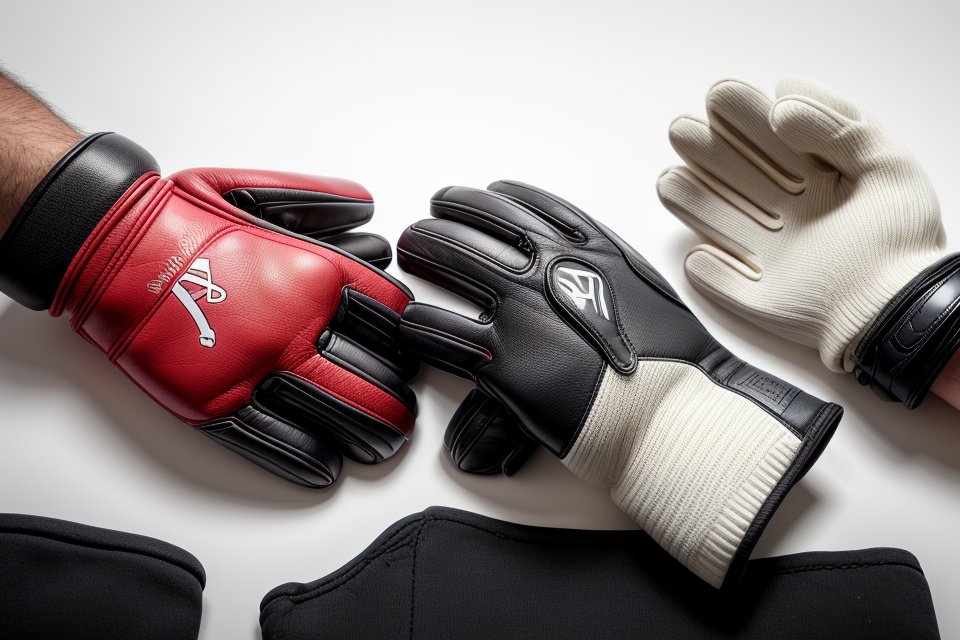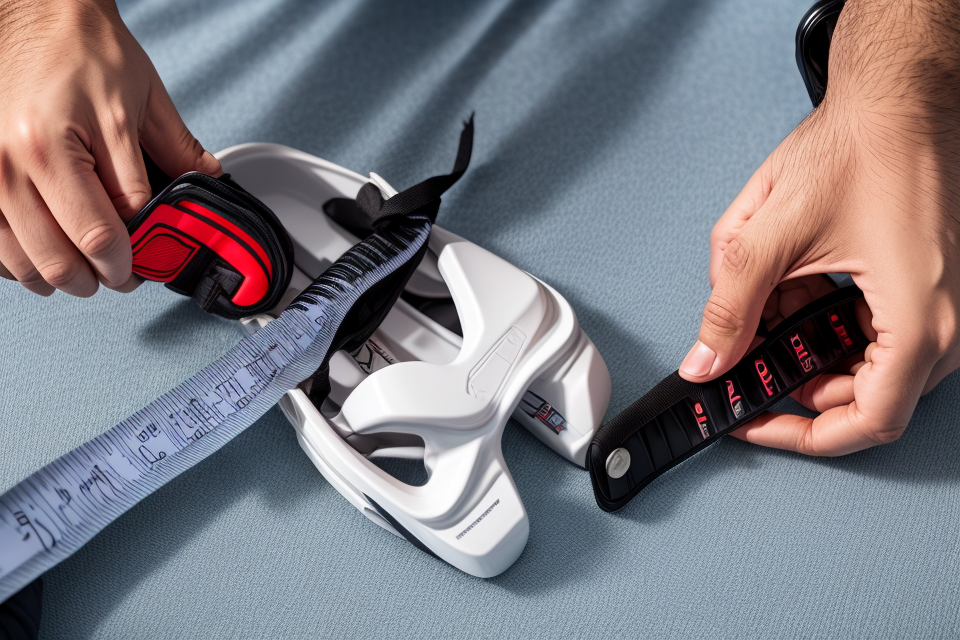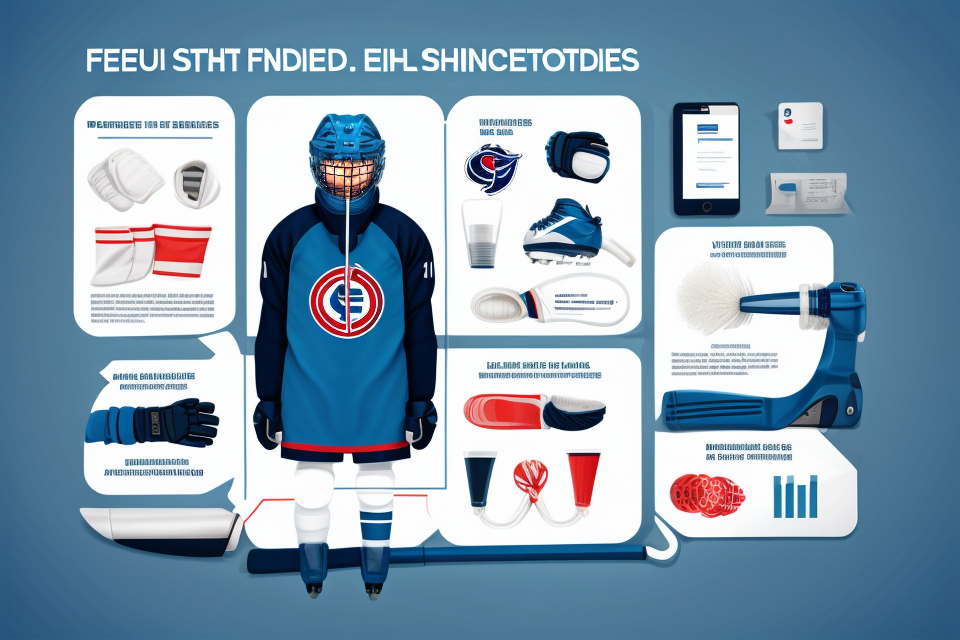Hockey is a physically demanding sport that requires players to have the right gear to protect themselves from injuries. One piece of equipment that is essential for hockey players is a pair of gloves. However, there is a debate among players and coaches about whether hockey gloves need to be broken in. Some believe that breaking in the gloves is necessary to improve their performance, while others argue that it is not necessary. In this article, we will explore both sides of the debate and provide some insights into the topic. So, do hockey gloves really need to be broken in? Let’s find out!
The debate over whether hockey gloves need to be broken in is a topic of much discussion among players and experts alike. Some argue that breaking in your gloves is essential for maximum performance and comfort, while others believe that it is unnecessary and that gloves should be ready to play in right out of the box. Ultimately, the decision of whether to break in your gloves or not comes down to personal preference and the specific needs of the player. However, most experts agree that breaking in your gloves can improve the fit, feel, and overall performance of the glove, making it a worthwhile step for many players.
What is the Purpose of Breaking in Hockey Gloves?
Improving Fit and Comfort
When it comes to breaking in hockey gloves, one of the primary goals is to improve their fit and comfort. There are several reasons why breaking in your gloves can lead to a better fit and more comfortable experience.
- Reducing Stiffness: One of the main reasons why hockey gloves need to be broken in is to reduce their stiffness. New gloves are often rigid and unyielding, which can make them uncomfortable to wear and limit your range of motion. By breaking in your gloves, you can loosen up the materials and allow for a more natural fit.
- Enhancing Range of Motion: As well as reducing stiffness, breaking in your gloves can also help to enhance your range of motion. This is because new gloves can restrict your movements, making it difficult to make quick and precise movements with your hands. By breaking in your gloves, you can increase your range of motion and make it easier to move your hands in any direction.
- Allowing for a Snugger Fit: Finally, breaking in your gloves can also allow for a snugger fit. When you first put on a new pair of gloves, they may feel loose and ill-fitting. However, by breaking them in, you can stretch out the materials and allow for a more snug and comfortable fit. This can help to reduce the risk of your gloves coming loose during play and give you greater control over your movements.
Enhancing Performance
One of the primary reasons for breaking in hockey gloves is to enhance performance. This includes improving grip on the stick, providing better protection against impacts, and enhancing wrist support.
- Improving Grip on the Stick
Hockey gloves are designed to provide a firm grip on the stick, which is essential for controlling the puck and making accurate passes. However, some players may find that their gloves do not provide the necessary grip right out of the box. Breaking in the gloves can help improve the grip by softening the material and allowing it to conform to the shape of the player’s hand. This can result in better control and more precise movements on the ice. - Providing Better Protection Against Impacts
Hockey is a physically demanding sport that involves a lot of body contact and collisions. Breaking in hockey gloves can help provide better protection against impacts by allowing the gloves to better conform to the shape of the player’s hands and wrists. This can help reduce the risk of injuries such as sprains, strains, and fractures. - Enhancing Wrist Support
In addition to providing protection against impacts, breaking in hockey gloves can also help enhance wrist support. The wrists are a crucial part of the body that is vulnerable to injury in hockey. By breaking in the gloves, the player can ensure that their wrists are well-supported and protected during play. This can help reduce the risk of wrist injuries and allow the player to perform at their best.
Do All Hockey Gloves Need to be Broken In?
Factors Affecting the Need for Breaking In
- Type of Glove
- Pro: The anatomical shape and snug fit of pro-style gloves require breaking in to allow for maximum mobility and performance.
- Con: Recreational gloves may not need to be broken in as they are often designed for comfort and basic protection rather than performance.
- Material Used
- Leather gloves: Require more time and effort to break in compared to synthetic materials, but offer better durability and a more comfortable fit over time.
- Synthetic materials: Generally have a shorter break-in period and may not require the same level of conditioning as leather gloves.
- Player’s Style of Play
- Power players: May benefit from breaking in their gloves for increased control and accuracy, as they often require more precision in their shots.
- Skill players: May not require as much break-in time, as they often prioritize speed and agility over precision.
- Level of Play
- Elite players: May require more extensive break-in periods to ensure optimal performance and a customized fit.
- Recreational players: May not need to break in their gloves as extensively, as they may not have the same level of technical skill or physical demands on their equipment.
Opinions from Hockey Experts
When it comes to the topic of breaking in hockey gloves, there are varying opinions among hockey experts. Some argue that breaking in gloves is crucial for optimal performance, while others believe that it is not necessary.
Opinion 1: The Importance of Breaking in Gloves
One group of experts believe that breaking in gloves is essential for optimal performance. They argue that gloves that are not broken in can be stiff and uncomfortable, leading to decreased dexterity and reduced ability to control the puck. Additionally, gloves that are not broken in may not fit properly, leading to reduced hand mobility and reduced grip strength.
Opinion 2: The Myth of Breaking in Gloves
Another group of experts believe that the concept of breaking in gloves is a myth. They argue that gloves are already designed to fit comfortably and provide optimal performance right out of the box. They contend that breaking in gloves is unnecessary and may even lead to injury if the gloves become too soft and do not provide adequate protection.
Opinion 3: Personal Preference
Some experts believe that the decision to break in gloves ultimately comes down to personal preference. They argue that some players may prefer gloves that are broken in, while others may prefer gloves that are not. Ultimately, it is up to the individual player to decide what works best for them.
In conclusion, the debate over whether hockey gloves need to be broken in is a topic of much discussion among hockey experts. While some argue that breaking in gloves is essential for optimal performance, others believe that it is a myth and that gloves are already designed to fit comfortably and provide adequate protection. Ultimately, the decision to break in gloves comes down to personal preference.
How to Break in Hockey Gloves
Pre-Break in Methods
When it comes to breaking in hockey gloves, there are a few different methods that players and coaches swear by. Here are three pre-break in methods that you can try before stepping on the ice:
Method 1: The Freezer Method
One popular method for breaking in hockey gloves is the freezer method. To use this method, simply place your new gloves in the freezer for a few hours or overnight. This will help to break down the materials and allow for a better fit. When you’re ready to use your gloves, take them out of the freezer and let them sit at room temperature for a few hours before putting them on.
Method 2: The Microwave Method
Another method for breaking in hockey gloves is the microwave method. To use this method, place your gloves in a microwave-safe bag and heat them up for 30 seconds to a minute. Be careful not to overheat your gloves, as this can cause damage to the materials. Once heated, let your gloves sit at room temperature for a few hours before putting them on.
Method 3: The Warm Water Method
The warm water method is a simple and effective way to break in your hockey gloves. Simply submerge your gloves in warm water and let them soak for a few minutes. This will help to soften the materials and allow for a better fit. Once your gloves have soaked, rinse them off and let them air dry before putting them on.
These are just a few of the pre-break in methods that you can try to get your hockey gloves ready for the ice. It’s important to note that while these methods can help to break in your gloves, they may not work for everyone. Ultimately, the best way to break in your hockey gloves is through consistent use and maintenance.
Maintenance During Break-In Period
Breaking in your hockey gloves is an essential part of preparing for the game. However, once you have broken them in, you need to maintain them properly during the break-in period. Here are some maintenance tips that you can follow:
Method 1: Wearing the Gloves for an Extended Period
One of the best ways to maintain your hockey gloves during the break-in period is by wearing them for an extended period. This means that you should wear your gloves for as long as possible during practice and games. This will help the gloves to mold to the shape of your hands and fingers, providing a better fit and improved grip.
Method 2: Using a Glove Conditioner
Another way to maintain your hockey gloves during the break-in period is by using a glove conditioner. A glove conditioner is a special lubricant that is designed to help break in the gloves and improve their flexibility. To use a glove conditioner, simply apply a small amount to the palm of your hand and work it into the glove using your fingers. This will help to soften the glove and make it more comfortable to wear.
Method 3: Using a Heat Gun
Finally, you can use a heat gun to help break in your hockey gloves. A heat gun is a small device that uses heat to soften the materials in your gloves, making them more flexible and easier to break in. To use a heat gun, simply turn it on and hold it against the palm of your hand for a few seconds. This will help to soften the materials in your gloves, making them easier to bend and flex.
In conclusion, maintaining your hockey gloves during the break-in period is crucial to ensuring they perform optimally on the ice. By following these simple maintenance tips, you can help to prolong the life of your gloves and ensure they provide the support and protection you need during the game.
Post-Break in Methods
There are several methods that can be used to break in hockey gloves after they have already been broken in. Here are three methods that are commonly used:
Method 1: Use a Heat Gun
One method to break in hockey gloves is to use a heat gun. This method involves using a heat gun to apply heat to the gloves in order to stretch them out. To use this method, place the gloves on a flat surface and direct the heat gun at them for several minutes. It is important to be careful when using a heat gun, as it can cause the gloves to become too stretched out if used for too long.
Method 2: Use Water
Another method to break in hockey gloves is to use water. This method involves soaking the gloves in water and then stretching them out. To use this method, fill a sink or basin with warm water and place the gloves in the water. Soak the gloves for several minutes, then remove them from the water and stretch them out. It is important to be careful when stretching the gloves, as they can become too stretched out if they are not handled properly.
Method 3: Use a Ball
A third method to break in hockey gloves is to use a ball. This method involves using a ball to break in the gloves by repeatedly catching and throwing the ball with the gloves on. To use this method, simply catch and throw the ball with the gloves on for several minutes. This method is effective because it not only stretches the gloves out, but it also helps to break them in and make them more comfortable to wear.
It is important to note that these methods should only be used after the gloves have already been broken in. Over-breaking in gloves can cause them to become too stretched out and lose their shape, which can lead to a decrease in performance. Therefore, it is important to only use these methods to fine-tune the fit and feel of the gloves after they have already been broken in.
Benefits of Breaking in Hockey Gloves
Enhanced Comfort
- Improved Fit
- Reduced Pain and Discomfort
- Better Blood Flow
Improved Fit
Breaking in hockey gloves can improve their fit, allowing them to conform to the shape of your hands and providing a more personalized feel. A properly broken-in glove will hug your hands snugly, providing better support and reducing the risk of injuries.
Reduced Pain and Discomfort
A well-broken-in glove can also reduce pain and discomfort caused by prolonged wear. The breaking-in process helps distribute the weight of the glove evenly, reducing pressure on specific areas of your hands. This can help alleviate discomfort caused by chafing, blisters, or other irritations.
Better Blood Flow
Breaking in your hockey gloves can also improve blood flow to your hands, which can enhance your performance on the ice. Properly broken-in gloves allow for better circulation, which can help prevent numbness or tingling in your fingers. This can also help improve your grip on your stick, giving you better control over your movements.
Improved Performance
Breaking in hockey gloves is a common practice among players, and for good reason. It has been argued that breaking in hockey gloves can improve a player’s performance on the ice in several ways. Here are some of the key benefits:
- Better Grip on the Stick
One of the most important aspects of hockey is having a good grip on your stick. This allows you to control the puck and make quick movements in any direction. Breaking in your hockey gloves can help improve your grip on the stick by making it feel more comfortable and natural in your hand. This can help you maintain better control of the puck and make more accurate passes and shots. - Increased Protection Against Impacts
Hockey is a physically demanding sport, and players are always at risk of sustaining injuries. Breaking in your hockey gloves can provide an added layer of protection against impacts and collisions on the ice. The gloves will become more flexible and form-fitting over time, which can help absorb shock and reduce the risk of injuries to your hands and wrists. - Improved Wrist Support
In addition to providing protection against impacts, breaking in your hockey gloves can also improve wrist support. The gloves will become more flexible and comfortable over time, which can help reduce fatigue and provide better support for your wrists during gameplay. This can help prevent wrist injuries and allow you to play at your best for longer periods of time.
Overall, breaking in your hockey gloves can have a significant impact on your performance on the ice. By improving your grip on the stick, providing increased protection against impacts, and improving wrist support, you can play at your best and help your team win games.
Long-Term Benefits
Breaking in hockey gloves may seem like a time-consuming task, but there are long-term benefits that make it worth the effort.
- Longer Glove Lifespan
One of the most significant advantages of breaking in hockey gloves is that it extends their lifespan. By properly breaking in your gloves, you can prevent premature wear and tear, which can result in your gloves needing to be replaced sooner than necessary. Additionally, a properly broken-in glove is less likely to experience stretching or sagging over time, ensuring that it stays in good condition for longer. - Consistent Performance Over Time
Breaking in your hockey gloves also ensures consistent performance over time. A well-broken-in glove will provide a snug fit and superior protection, which can enhance your gameplay. It can also help improve your grip on the stick, which is essential for accurate shooting and passing. As a result, breaking in your gloves can help you maintain your performance level throughout the season. - Easier Maintenance
Another long-term benefit of breaking in your hockey gloves is that it makes maintenance easier. A broken-in glove is less likely to need frequent repair or replacement, saving you time and money in the long run. Additionally, breaking in your gloves can help prevent uncomfortable break-in periods later on, as your gloves will already be molded to your hand. This means that you can spend more time on the ice and less time worrying about your equipment.
FAQs
1. What is the purpose of breaking in hockey gloves?
The purpose of breaking in hockey gloves is to mold the glove to the shape of the player’s hand, improving comfort, control, and flexibility. This process helps the glove fit better and feel more natural during gameplay.
2. How long does it take to break in hockey gloves?
The break-in period for hockey gloves can vary depending on the quality of the glove and the individual’s hand shape. Generally, it takes around 10-20 hours of use for the glove to fully break in. However, some players may notice an improvement in fit and feel after just a few hours of use.
3. Is it necessary to break in hockey gloves?
While breaking in hockey gloves is not strictly necessary, it can greatly improve the fit, feel, and performance of the glove. Players who choose not to break in their gloves may experience a less comfortable and less flexible glove that doesn’t fit their hand as well.
4. Can hockey gloves be broken in too much?
It is possible to over-break in hockey gloves, which can lead to a glove that is too loose and doesn’t provide the support and control needed during gameplay. It’s important to find a balance in the break-in process, using the glove for its intended purpose while still allowing it to adapt to the shape of your hand.
5. How should I break in my hockey gloves?
To break in your hockey gloves, wear them for as long as possible during practice and games. It’s also helpful to use the gloves for non-hockey activities, such as grip exercises or manual labor, to increase the flexibility and shape of the glove. Additionally, using a glove conditioner or moisturizer can help soften the material and speed up the break-in process.
6. Can I break in my hockey gloves at home?
Yes, you can break in your hockey gloves at home using the same methods as described above. However, some players prefer to break in their gloves gradually over a longer period of time, using them for practices and games and then slowly increasing the intensity of their on-ice activities.
7. Will breaking in my hockey gloves affect their performance?
Breaking in your hockey gloves can actually improve their performance by making them fit better and feel more comfortable and natural during gameplay. While some players may experience a brief adjustment period as they get used to the feel of their new gloves, breaking in the gloves is ultimately beneficial for both comfort and performance.



